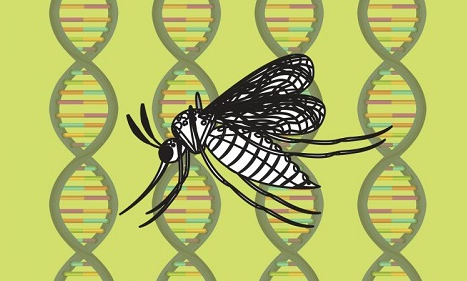A team of Indian scientists develope a mechanism to eliminate mosquitoes on a large scale. The approach, which has been tested on a pilot basis, is to artificially introduce RNAi into the cells of mosquitoes that can eliminate them and thus control its population.
Puducherry (ISJ) – A team of Indian scientists have developed a mechanism to eliminate mosquitoes on a large scale. The approach, which has been tested on a pilot basis, is to artificially introduce RNAi into the cells of mosquitoes that can kill them and control its population.
A recent review led by Dr. A. Balakrishna Pillai from the Central Inter-Disciplinary Research Facility (CIDRF) at Sri Balaji Vidyapeeth University, Puducherry has discussed the mechanism of action, effective methods to deliver these RNA into the bodies of mosquitoes and current trends in the usage of this method on a large scale.
RNA interference is a widely used technique in the field of molecular biology to study basic molecular processes. In this method, a specific gene can be ‘silenced’ or ‘knocked out’ at will by injecting small bits of double stranded RNA molecules into cells (also called siRNAs or interference RNAs). By ‘knocking out’ a specific gene, scientists can tell what function the gene performs by looking at what ‘character’ is lost. Now researchers are using this method to cripple mosquitoes, either adults or larvae, by ‘knocking out’ some essential genes that are vital for the survival of mosquitoes or the pathogens they host.
“RNAi is employed to decipher the role of genes involved in mosquito immune response towards disease causing pathogens. This would allow us to identify the vector molecules that may resist the development of pathogens inside mosquito hosts,” Dr. Agiesh Kumar, the lead author of this study said.
So far, RNA interference has been used to study the interaction between the mosquito Anopheles gambiae and the malaria causing pathogen Plasmodium falciparum. It has also been used to control dengue virus in the mosquito Aedes aegypti.
RNA interference evolved as an arm of immune system to fight against foreign double stranded RNA (including RNA viruses). When a foreign RNA enters our cells either by infection or by artificially insertion, it is first broken down into small pieces of a specific length called ‘small interfering RNAs (siRNA)’ by an enzyme called dicer. These siRNAs are then stripped into single stranded RNAs and loaded into a protein complex called RISC (RNA-Induced Silencing Complex), which specializes in cutting double stranded RNA.
Mosquitoes also raise immune response against the viral pathogen. “RNAi could be used to understand such molecules involved in mosquito immune response that may resist or facilitate the development of pathogens,” explained Dr. Agiesh Kumar. “By systematically silencing genes that are suspected to be involved in vital interactions, we could gain valuable insights about these interactions that might help us in our fight against mosquito-borne diseases.”
With such promising results how can these dsRNA- the initiators of RNAi, be delivered into mosquitoes? For adults, dsRNA can be directly injected into their body using a micro syringe. But this method cannot be applied on a larger scale where the goal is to control or clear mosquito population from an infested habitat.
“A practical way to control mosquitoes is to convert dsRNA into nanoparticles and mix it with larval food is one way of eradicating mosquitoes. The second possibility is developing a spray, which contains dsRNA,” Dr. Agiesh Kumar told Indian Science Journal. “We still have to evolve a technique to prepare a spray with dsRNA.” Based on a pilot study, he claimed, the efficacy of the method during could be about 80-85 per cent.
RNA based pesticides would have some crucial advantages over traditional chemical pesticides including safety, environment friendliness, minimal toxicity to undesired target animals, and minimization of resistance problem. There are still some hurdles to be overcome though. “A cost effective method needs to be devised and the stability of dsRNA must be ensured before large scale release,” said Dr. Agiesh Kumar.


